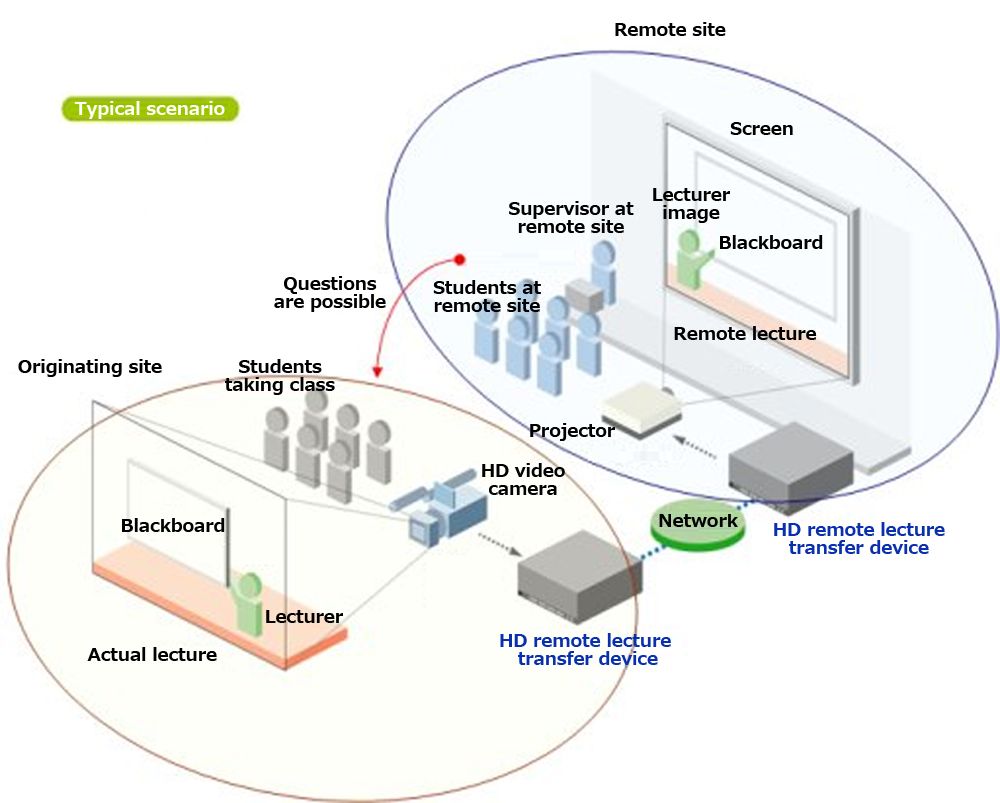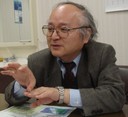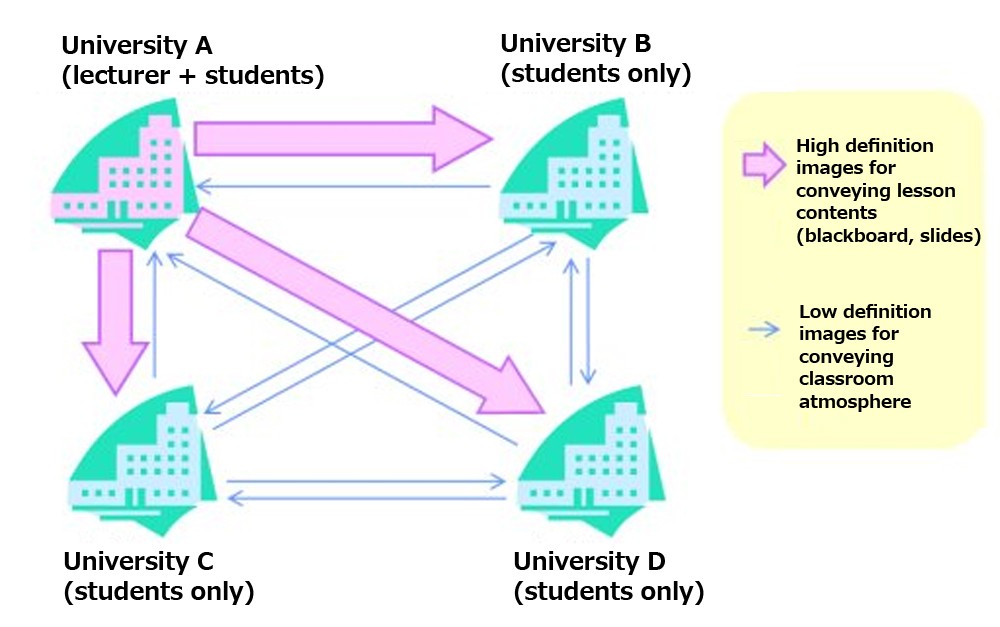
Use of HD Interactive Remote Lectures and IPv6 for Training in the Healthcare Information Field
The Yokohama National University Information Technology Service Center (ITSC), as one of the joint projects with Yokohama City University in the field of engineering-based medicine, has set up a high definition interactive remote learning system linking the Yokohama National University Graduate School of Environment and Information Sciences with the Yokohama City University Graduate School of Medicine. We talked with Professor Hiroshi Arisawa of the Graduate School of Environment and Information Sciences and ITSC Associate Professor Xu Haoyuan about the project, its successes to date, and its use of IPv6 currently being promoted.
(Interview date: December 11, 2008)
Please tell us a bit about the activities of the Yokohama National University ITSC.
Xu: The former YNU Information Processing Center was reorganized as the Information Technology Service Center in April 2007, with the role of providing an IT environment in the university and utilizing that environment in supporting and carrying out education and research activities. Among the specific services, administering the campus information communication network and ensuring information security are the responsibility of the Information Network division, while the Education Support Systems division is in charge of maintaining the approximately 600 classroom PCs, running the school-wide email system, and providing educational services in the information processing field. In addition to these two divisions, a major feature of this Center is the existence of multiple research project divisions. These divisions solicit and choose participants in advanced projects carried out to raise the level of the information infrastructure.
You are now collaborating with Yokohama City University on an engineering-based medicine project.
How did this come about?
Arisawa: Lately IT support has become indispensible for those working in such areas as medical treatment, nursing care, welfare, and elderly care. An important task for our Faculty of Environment and Information Sciences is to produce graduates with a high level of specialized skills for contributing in this field. One way we have responded to this challenge is by launching a program in the 2007 academic year for training people in the information sciences who will be active in the medical and welfare arenas. The program received funding from the Ministry of Education, Culture, Sports, Science and Technology (MEXT) under its Support Program for Improving Graduate School Education.
Among the many different activities being carried out in this program, the SIP (Student Initiative Production) Project is one in which students are taking the lead in developing software of use to medical and welfare caregivers. For example, software is being developed that performs computer analysis of the body movements of veteran caregivers in order to clarify the necessary know-how in this field. I should note that students who complete a required educational program including the SIP Project receive a certificate indicating that they have received a minor in healthcare information technology, which should benefit them greatly when they seek employment in the medical equipment industry.
Another important project under the MEXT graduate school education support program is the interactive remote learning system with the Yokohama City University Graduate School of Medicine. Basic knowledge of medicine is of course essential for anyone who wants to work in the medical and welfare field. Instructors in the Yokohama City University School of Medicine have busy schedules, however, making it difficult for them to come to our school regularly for instruction. This is why we decided to look into remote learning over a network.
Were there certain things you had to pay special attention to in implementing the interactive remote learning system?
Arisawa: One was transmitting high definition images in real time. An ordinary video conferencing system tends to lack the image quality needed for showing documents and so on legibly. This is a big problem in classes on healthcare information. And simply playing back recorded images would not result in the desired sense of presence and stimulation at either the sending or receiving ends of the classes.
To resolve these issues, we developed a new HD relay system for interactive remote learning. This system allows the instructor to see what is going on both in the instructor’s own classroom and at the remote site while teaching the class, and lets students in the remote classroom ask questions of the instructor. The HD images show even small characters or figures on the blackboard legibly and show teaching materials clearly, which the participants really appreciate. Also, instead of using costly leased circuits, we use ordinary Internet links via a SINET node.
How are you using this system currently for lessons?
Arisawa: Medical courses such as Clinical Medicine, Introductory Medicine, Human Anatomy and Physiology and so on are provided to our students from Yokohama City University, while our school provides courses in information science such as Advanced Medical Imaging. When the project first began, it was limited to the two universities; but recently Keio University has started providing classes on Nursing and Welfare Engineering. We hope to tie up with various other schools in the future, broadening the interactive remote learning program. And since the course contents are valuable educational assets, we are in the process of developing a system for automatically generating course materials in HD format.
Have you begun any new projects for the future?
Arisawa: We are studying as the next step a program of international interactive remote learning with universities in China. Right now efforts are being made to increase the number of students coming to Japan for study of various kinds, but as a practical matter it is not all that easy to have large numbers of Chinese students come to Japan. At the same time, some Chinese universities are adding classes for enhancing Japanese language ability, so that in one department there are several hundred students learning Japanese. Using our remote learning system, it should be possible to provide classes taught in Japanese on Japanese university campuses to students in China over the network. Fortunately China also has a science information network like SINET, called Cernet. By all means we would like to realize international interactive remote learning in this way.
I also want to ask you about your involvement with IPv6.
First, please give us some background on IPv6 introduction.
Xu: As I noted at the beginning, our mission at ITSC includes providing the IT infrastructure for education and for R&D in the university. Since our desire is to equip the school with the most advanced information infrastructure as early as possible, introduction and use of IPv6 was a major theme. The direct occasion for its introduction was the start of IPv6 native routing service in SINET3 in December 2007. There were other options such as use of tunneling, but due to cost and other obstacles they are impractical at the university level. This made the SINET IPv6 native support all the more attractive to us. Right around that time we happened to be looking to upgrade the school’s backbone network, so we purchased a network system with dual-stack support and opted for full-scale IPv6 adoption. After readying new user rules and regulations, we started service in the university on December 1, 2008.
How exactly are you making use of IPv6?
Xu: We have just started offering the service, so it will be a while before people are taking full advantage of it. A number of potential uses have been raised, however, one of them being the remote lectures with China that Prof. Arisawa talked about. Universities in China have also been introducing IPv6, laying the groundwork for global IPv6 routing to proceed. Since there is plenty of available bandwidth, we would like to use IPv6 for international HD image transfer. We would be grateful for SINET support.
Finally, please tell us about your expectations of SINET.
Arisawa: When developing the system for interactive remote lecturing, we performed network tests and found SINET3 to have exceptional network quality. The provision of a high-performance, highly reliable network infrastructure is something we appreciate greatly, and we would be happy also for in-depth support in the research and development areas. We would also like it if you could provide more support to the many universities on SINET still suffering from less than optimal network infrastructures.




